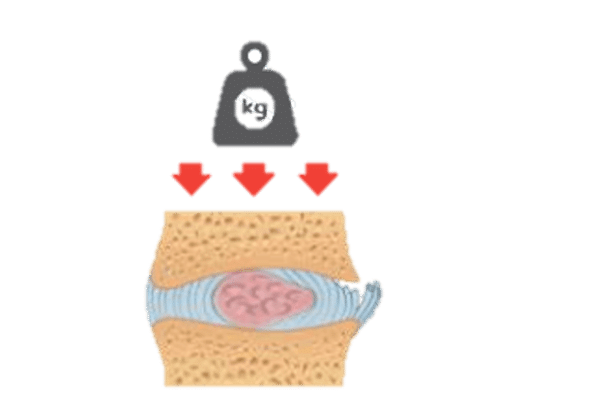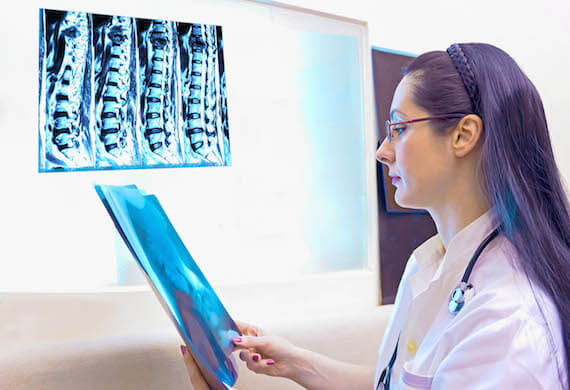Request Appointment
Enter your details and we will be in touch with you shortly;
Or call
8655885566
between 8 am and 8 pm.

Physical ache that arises in the neck and may radiate to shoulder, upper back and arm

Neck pain, often known as cervical spine pain, is in or around the spine beneath your head. Neck pain is the second most common problem relating to movable body parts, and it affects about two-thirds of the population, and almost 10% to 20% of these people have chronic neck pain, which lasts for more than 3 months. But, understanding the primary symptoms and causes, and then opting for personalized neck pain treatment can help prevent long-term discomfort and improve quality of life. For lasting relief, many individuals also benefit from personalized neck pain therapy that targets the underlying causes.
Please consult a doctor immediately if:
Living with neck pain can be challenging, but there are various approaches to manage and eventually reduce the discomfort. When seeking help, patients are often introduced to a comprehensive neck pain treatment program designed to address the root cause of the pain while improving mobility and function. These programs typically involve a combination of diagnostic assessments and individualized pain management plans.
Strains in the neck or even slight discomfort are not unusual, but it is important to note that some symptoms are present when it is time to see the doctor. If neglected, these signs may worsen the pain and cause more severe conditions in the future. Doctors may recommend targeted approaches like neck pain relief therapy to manage persistent symptoms.
You should see a doctor if:
In some cases, they may suggest cervical traction to reduce pressure on the spinal discs and improve mobility. For many patients, gentle neck pain relief exercises under expert supervision can significantly improve flexibility and reduce tension. So always seek early diagnosis and ensure to plan well on the way forward to get your neck back to its healthiest form and to prevent further discomfort or pain.
 Professional diagnosis required
Professional diagnosis required Chronic, can last for years
Chronic, can last for years Treatable with 4 weeks of QI Spine Therapy
Treatable with 4 weeks of QI Spine TherapyNeck pain usually shows up because of aging, postural, and mechanical irregularities in people. However, there are some deeper issues like:
In the case of asymptomatic chronic neck pain, a pain caused by mechanical and degenerative factors is called cervical spondylosis. It is also referred to as cervical osteoarthritis or neck arthritis.
Pain in the neck is one of the usual complaints for people, regardless of the age factor. But it often occurs as a result of an ailment, although a great deal of neck pain may be likely to be caused by behaviours. Identifying the possible reasons will aid in choosing the best methods for alleviation and rehabilitation.
Chronic Conditions: Some cases are worsened by autoimmune disorders or long-standing muscular imbalances.
 Professional diagnosis required
Professional diagnosis required Chronic, can last for years
Chronic, can last for years Treatable with 4 weeks of QI Spine Therapy
Treatable with 4 weeks of QI Spine Therapy Neck Pain Treatment and Management
The neck pain is a widespread complaint and can be of musculoskeletal origin due to straining or can be caused by worn-out joints, just like any other joint in the body or could result from nerve compression. It is widely encouraged that the first thing that should be done in a management process is to make a clinical assessment to determine the root cause. According to the findings, both conservative and interventional therapies that are specific to the patient are established.
For a diagnosis of the causes of neck pain, a patient must undergo a preliminary history, physical examination, and imaging, if needed.
For most patients, the initial step involves non-surgical neck pain solutions that emphasize activity modification and targeted rehabilitation.
If the cyst is located close to the nerve roots, an inflamed area can be made, and pain can then be relieved.
To begin with, the measure of decentralization that can be applied instantly, doctors advise the following interventions:
When nerve involvement is suspected, Pinched nerve treatment is critical to reducing nerve compression and its associated symptoms. In some cases, Acupuncture for neck pain is used as an adjunct therapy to further alleviate pain.
Effective Posture correction for neck pain is vital, especially in patients with sedentary lifestyles. This strategy ensures that one does not apply pressure on the cervical spine during the day.
Combining all these elements forms a robust strategy for neck pain treatment and neck pain therapy. It also solves pain and the function of the body suffering from the pain is also restored thereby avoiding further pains in future hence increasing the quality of life.
As a result of the effective implementation of the evidence based interventions as well as comprehensive lifestyle changes that has been prescribed, the patient is then educated about ways in which they can avoid the pain in the neck in the future.
Preventing neck pain involves a combination of healthy lifestyle habits and ergonomic practices. Medically, it is essential to maintain a proper workstation setup and engage in regular exercise to keep the cervical muscles strong and flexible. You can follow these simple steps:
To work effectively while sitting, it is vital to adjust the working environment to enable the right posture to be observed.
Make sure that the monitor is placed at eye level and the chair you use is adjustable for your back support.
Often take breaks in between long sitting at the desk and chair.
Perform cervical extension exercises to keep the flexibility of various muscles in the cervical region.
Take regular step that is aimed at massaging the muscles of the neck and shoulder in order to prevent the occurrence of such strains.
Consider Chiropractic care for neck pain to help maintain spinal alignment and alleviate muscle tension.
Implement Posture correction for neck pain techniques throughout daily activities to minimize stress on the cervical spine.
Neck pain can be relieved at home with simple methods. However, if the pain persists, the following treatment is recommended:
DSA: DSA (Digital Spine Analysis test), which helps in analyzing the root cause of the problem. It is a non-invasive functional test that helps in measuring spine function. Its controlled and guided movements help in determining the mobility of the spine, strength, and imbalances of muscles around the spine.
 Professional diagnosis required
Professional diagnosis required Chronic, can last for years
Chronic, can last for years Treatable with 4 weeks of QI Spine Therapy
Treatable with 4 weeks of QI Spine TherapyNeck pain can be relieved at home with simple methods. However, if the pain persists, the following treatment is recommended:
If your neck pain is mild or moderate, you can manage the pain by:
 Professional diagnosis required
Professional diagnosis required Chronic, can last for years
Chronic, can last for years Treatable with 4 weeks of QI Spine Therapy
Treatable with 4 weeks of QI Spine TherapyThe diagnosis of neck pain is always systematic. Doctors start with the practice called an anamnesis, where patient’s history is revealed including when the pains started, how long they have been present, and what type of pains. These includes those in the limbs like numbness, tingling or those radiating pains and also about any activities done at work station such as sitting behind a desk, regular traveling among others. All this information lays the groundwork for further diagnostics.
The experienced physician gathers information, including history of earlier trauma, routine activities, and the development of the pain. It also aids in deciding if the pain is of short-term, of some period, or long-lasting.
The cervical area of the spine is assessed and checked for tender areas, muscle contraction, and limited mobility. Strength tests have beneficial effects, such as defining a range of motion that points to musculoskeletal disorders.
Sometimes, clinicians recommend a trial period of Neck pain relief exercises. The manner in which patients react to such exercises provides information on the extent of the situation and guides the following actions that should be taken.
The proposed management plan can be formulated in a group with the patient after obtaining all the necessary data. Such may involve lifestyle changes and ergonomics, which are non-invasive as explained below. It can also incorporate neck pain therapy sessions to address muscle tension and improve mobility. For many patients, the recommended interventions form part of an overall neck pain treatment plan that is uniquely designed based on diagnostic findings and patient needs.
In cases where conservative measures are prioritized, a well-structured neck pain relief treatment is implemented to alleviate pain and restore function. In the given comprehensive diagnostic approach, the signs and actual symptoms of neck pain are uncovered, with the necessary treatment approaches offered for the problem to have an improved quality of life.






Have a question?
Ask our spine specialists
Who is a QI Spine Specialist?
A QI Spine Specialist is a medical expert with

Dr. Nidhi Sanghvi Shah

Dr. Shital Gaikwad

Dr. Richa Bhatia
9000 hours
of specialisation in treating back and neck conditions
32 hours
of spine physiotherapy specialisation methods in McKenzie concepts, Kinetic control, Neurodynamic solutions, Mulligan’s concepts
500 hours
and 6 months of QI Spine specialisation courses
Ice and heat pads should be applied and proper, gentle massaging should be carried out to help relax the contracting muscles. Combining these measures with professional neck pain treatment can significantly reduce discomfort quickly.
Some of the suggested exercises that should be done daily are chin tucks, neck rotation exercises, shoulder shrugs, and gentle neck banging exercises. These specific exercises help improve flexibility and posture, forming an essential part of neck pain therapy.
If a person suffers from severe neck pain along with such characteristics as numbness in the arms, weakness, or impaired balance, it is better to consult a medical professional. If these occur or the pain worsens despite rest, it’s important to seek medical evaluation as specialized neck pain relief therapy may be necessary.
Healing time depends on the underlying cause and severity; acute cervicalgia may improve within a few weeks, while chronic cases might require ongoing neck pain treatment and neck pain therapy for several months to achieve lasting relief.